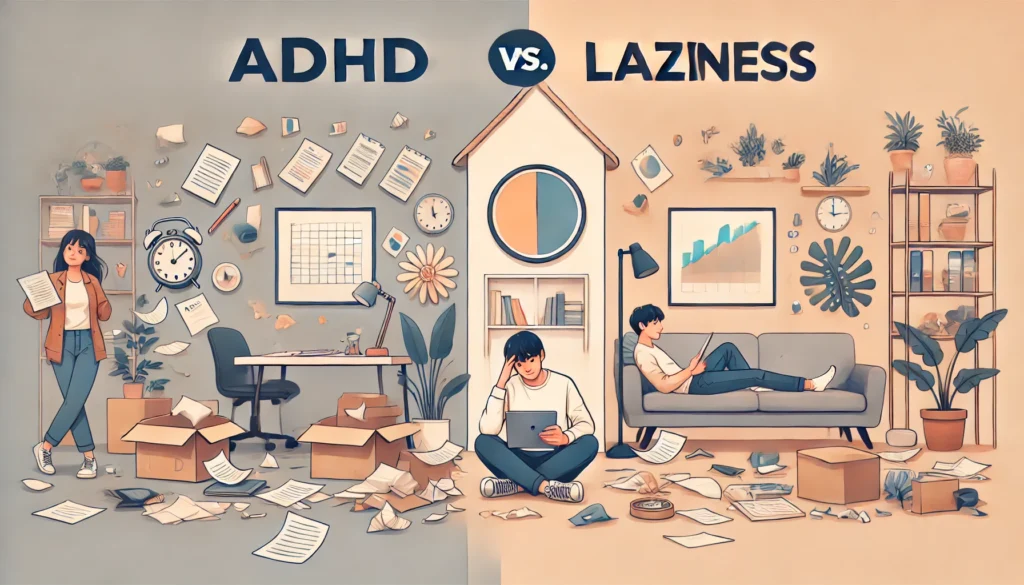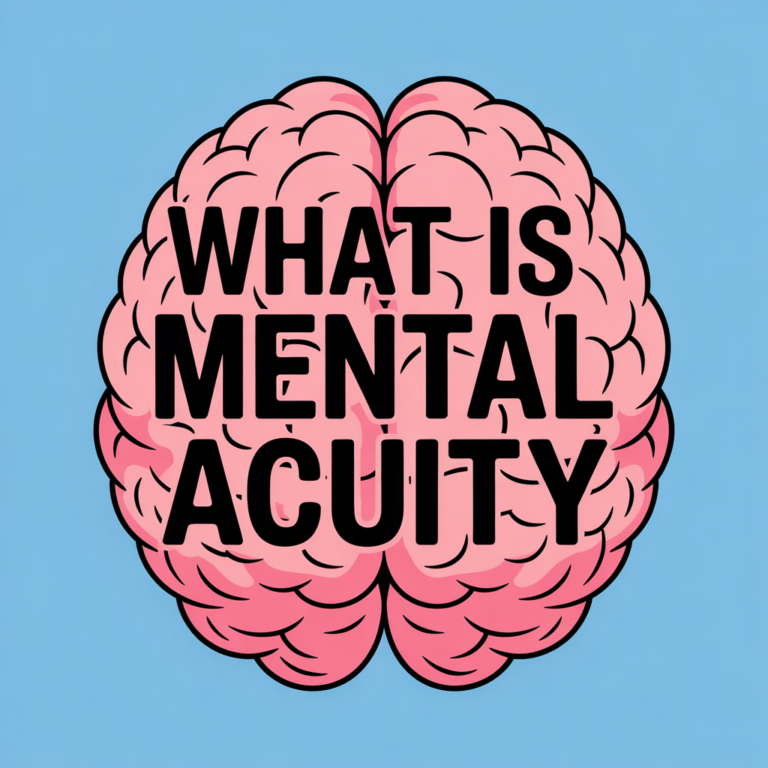At some point, almost everyone has asked themselves, do I have ADHD or am I just lazy? It’s a common question because the behaviors associated with both conditions—like procrastination, disorganization, and difficulty focusing—can look similar. However, the underlying causes and appropriate responses to these behaviors differ greatly. ADHD (Attention-Deficit/Hyperactivity Disorder) is a recognized medical condition that impacts the brain’s ability to regulate attention and impulses, while laziness is typically a temporary lack of motivation. This article will guide you through understanding the key differences between ADHD and laziness, providing strategies for overcoming both.
What Is ADHD?
ADHD is a neurodevelopmental disorder that affects a person’s ability to focus, control impulses, and manage time effectively. It is often diagnosed in childhood but can persist into adulthood. There are three main types of ADHD:
- Inattentive Type: Difficulty sustaining attention, being easily distracted, and trouble with organization and following through on tasks.
- Hyperactive-Impulsive Type: Fidgeting, excessive movement, difficulty staying seated, and acting without thinking.
- Combined Type: A mixture of both inattentive and hyperactive-impulsive symptoms.
ADHD is not a reflection of laziness or lack of effort; it is a medical condition that affects how the brain functions.
What Is Laziness?
Laziness is not a medical condition, but rather a behavior. It occurs when a person chooses not to engage in an activity, despite having the ability to do so. Laziness often stems from a lack of motivation, interest, or energy. Unlike ADHD, which affects multiple areas of life and has a neurological basis, laziness tends to be situational. A person may feel lazy about one task but be highly motivated in other areas. This temporary state can usually be overcome by improving motivation or changing habits.
ADHD vs. Laziness: Key Differences

When asking, do I have ADHD or am I just lazy, it’s important to recognize the fundamental differences between the two. While both ADHD and laziness can result in procrastination, difficulty completing tasks, and a lack of motivation, they stem from very different causes. ADHD is a chronic neurological condition that impacts multiple areas of life, whereas laziness is a temporary state influenced by mood or external factors. Let’s break down these key differences in more detail.
1. Effort vs. Ability to Focus
One of the key differences between ADHD and laziness is the amount of effort involved. Individuals with ADHD often put in a lot of effort to stay focused or complete tasks, but their brain’s difficulty with attention and impulse control prevents them from doing so consistently. On the other hand, laziness often involves a conscious decision not to exert effort. A lazy person may have the ability to complete a task but chooses not to due to a lack of motivation or interest.
2. Consistency of Symptoms
ADHD symptoms are persistent and affect various aspects of life, from work and school to personal relationships. These symptoms do not fluctuate based on mood or external circumstances—they are a constant presence. Laziness, however, is often situational and temporary. A person may feel lazy in specific scenarios, such as completing a boring task, but can be highly productive in other areas of their life.
3. Motivation Levels
For individuals with ADHD, motivation doesn’t always align with their ability to focus. Even when they are motivated to complete a task, their brain chemistry can prevent them from following through. This is different from laziness, where a lack of motivation is the primary issue. Someone who is lazy may struggle to start a task simply because they don’t feel like doing it, but once motivated, they can often complete the work without difficulty.
4. Impact on Daily Life
ADHD impacts nearly every aspect of daily life. From managing time and responsibilities to maintaining relationships, the challenges of ADHD can make everyday tasks feel overwhelming. Laziness, however, typically affects specific tasks rather than overall functioning. A person who is lazy might neglect certain responsibilities but can still manage other areas of their life without significant disruption.
5. Response to Pressure or Deadlines
People with ADHD may find that even external pressure or deadlines don’t significantly improve their ability to complete tasks. They often struggle with time management and prioritization, making it difficult to meet deadlines, even when they feel the urgency. In contrast, someone who is lazy may find that pressure or a looming deadline helps them kick into gear and complete a task at the last minute.
6. Biological and Neurological Roots
ADHD is a neurological disorder that affects how the brain functions, particularly in areas related to attention, focus, and impulse control. This biological difference makes ADHD a chronic condition that requires treatment and management. Laziness, by contrast, is behavioral and does not have a neurological basis. It can usually be resolved by addressing underlying factors like motivation, interest, or fatigue.
7. Effort Doesn’t Always Lead to Results
For people with ADHD, putting in effort doesn’t always result in productive outcomes. Despite their best intentions and hard work, they may still struggle to complete tasks due to distractibility, impulsiveness, or forgetfulness. This can be frustrating and demoralizing. On the other hand, someone who is lazy might not experience this same frustration because their lack of productivity stems from a conscious choice rather than an inability to focus.
8. Duration and Impact of Symptoms
ADHD is a long-term, chronic condition that can affect people throughout their lives if left untreated. Its symptoms are constant, whether the individual is highly motivated or not. Laziness, however, is temporary and can often be overcome when the person is sufficiently motivated or interested in a task. The duration of laziness is much shorter, and its impact is usually confined to specific tasks or periods.
Recognizing ADHD Symptoms

To answer the question, do I have ADHD or am I just lazy? It’s essential to recognize the common symptoms of ADHD. These include:
- Difficulty Sustaining Focus: Constantly losing track of what you’re doing, even with tasks you find interesting.
- Procrastination: Putting off important tasks until the last minute and struggling to start projects.
- Disorganization: Trouble keeping track of time, materials, or tasks, leading to missed deadlines and forgotten obligations.
- Impulsivity: Making quick decisions without considering the consequences or interrupting others frequently.
- Hyperactivity: Fidgeting, restlessness, and an inability to stay still, even in situations that require calmness.
If these symptoms sound familiar and persist in different areas of your life, it’s worth exploring whether ADHD may be the root cause.
Overcoming Laziness: Key Tips

If you’ve determined that laziness, rather than ADHD, is the issue, don’t worry—there are several strategies you can use to boost your motivation and productivity. Here are some practical tips to help you overcome laziness and get back on track.
1. Break Tasks into Small Steps
One of the biggest reasons people feel lazy is because they are overwhelmed by the size of a task. Breaking tasks down into smaller, more manageable steps can make them feel less daunting. Instead of thinking about completing an entire project, focus on starting with just one small step. For example, if you need to clean your house, start by organizing one room or even one area of the room. This creates momentum and makes the larger task feel more achievable.
2. Use the Pomodoro Technique
The Pomodoro Technique is a time management method that helps fight procrastination and laziness. Set a timer for 25 minutes and focus on a single task during that time. After the timer goes off, take a five-minute break. Repeat this process for four cycles, then take a longer break of 15-30 minutes. This method can help improve focus and productivity by breaking tasks into short, focused intervals, making them easier to manage.
3. Find Your Motivation
Sometimes laziness stems from not understanding why a task is important. To overcome this, find your “why”—the reason you need to complete the task. Whether it’s the satisfaction of finishing something, a financial reward, or the long-term benefits of completing a project, understanding the purpose behind your efforts can provide the motivation you need to get started. If the task itself doesn’t seem meaningful, think about the larger goals it helps you achieve.
4. Set Clear, Achievable Goals
Another way to combat laziness is to set specific, achievable goals. Vague goals like “I need to get more work done” aren’t helpful because they lack clarity. Instead, break your goals down into actionable steps, such as “I will finish writing two pages of my report today.” When you have a clear target, it’s easier to stay focused and motivated.
5. Create a Productive Environment
Your environment can significantly impact your productivity and motivation. A cluttered, noisy, or uncomfortable space can make you feel more inclined to avoid tasks. Take the time to organize your workspace, eliminate distractions, and create an environment that supports productivity. This might mean turning off your phone, clearing your desk, or finding a quiet place to work. When your environment encourages focus, it becomes easier to overcome laziness.
6. Use Accountability to Stay on Track
Accountability is a powerful tool for overcoming laziness. When you know someone else is expecting you to complete a task, you’re more likely to follow through. You can create accountability by telling a friend or family member about your goals, joining a study or work group, or using productivity apps that track your progress. Knowing that someone else is checking in on your progress can provide the extra push you need to stay motivated.
7. Reward Yourself for Completing Tasks
Incentives can be a great way to boost motivation. Promise yourself a reward for completing a task, such as watching a favorite show, enjoying a snack, or taking a relaxing break. The key is to tie the reward to the completion of a task rather than using it as a distraction before the work is done. This system of rewards can help create positive reinforcement and make you more likely to tackle future tasks with enthusiasm.
8. Practice Self-Compassion
It’s important to recognize that everyone feels lazy from time to time. Instead of being hard on yourself when you procrastinate or lack motivation, practice self-compassion. Acknowledge that laziness is a natural feeling and that you can overcome it with the right strategies. Being kind to yourself helps reduce the negative emotions that can keep you stuck in a cycle of procrastination.
Managing ADHD Symptoms
If ADHD is the root cause of your struggles, it’s important to seek appropriate help and develop strategies for managing symptoms. Here are some effective ways to manage ADHD:
- Medication: ADHD medications, such as stimulants and non-stimulants, can help regulate neurotransmitters like dopamine and norepinephrine, improving focus and impulse control.
- Therapy: Cognitive-behavioral therapy (CBT) can help individuals with ADHD develop strategies for managing time, organizing tasks, and improving focus.
- Routine: Creating a structured routine with regular habits can help reduce the disorganization and impulsivity that often accompany ADHD.
- Assistive Tools: Tools like planners, apps, and timers can help individuals with ADHD stay organized and on track.
Conclusion: Do I Have ADHD or Am I Just Lazy?
In conclusion, answering the question, do I have ADHD or am I just lazy, requires a deeper understanding of your behaviors and patterns. ADHD is a chronic neurodevelopmental condition that impacts multiple areas of life and requires medical attention. Laziness, however, is a temporary state that can be improved with the right strategies and motivation. If you find that your struggles with focus, time management, and task completion are persistent and widespread, it may be time to seek a professional evaluation for ADHD. On the other hand, if laziness is the issue, try implementing the practical tips outlined in this article to boost your motivation and productivity.
FAQs
1. Can adults develop ADHD, or is it only a childhood condition?
ADHD is a neurodevelopmental disorder that typically begins in childhood, but many individuals are not diagnosed until adulthood. The symptoms of ADHD often persist into adult life, but the way they manifest may change over time. For example, hyperactivity in children may transform into restlessness or difficulty sitting still in adults. Adults who have had lifelong difficulties with focus, organization, and time management may have undiagnosed ADHD.
2. Can someone be both lazy and have ADHD?
Yes, it’s possible for someone with ADHD to experience periods of laziness, just like anyone else. Laziness is a temporary state, often due to lack of motivation or interest, while ADHD is a chronic condition that affects how the brain regulates attention and impulses. A person with ADHD may feel lazy in situations where they are overwhelmed or disinterested, but the two are not the same.
3. How can I tell if procrastination is due to ADHD or laziness?
Procrastination due to ADHD is often tied to feelings of being overwhelmed, disorganization, and difficulty focusing. Even when you want to get things done, your brain may struggle to manage tasks efficiently. Procrastination linked to laziness is usually temporary and can be overcome with enough motivation or external pressure. ADHD procrastination is more persistent and affects multiple areas of life.
4. What are the main differences between ADHD and laziness?
The primary difference between ADHD and laziness lies in the consistency and cause of the behavior. ADHD is a chronic condition that impacts focus, attention, and impulse control, often regardless of motivation or interest. Laziness is a choice or behavior, often influenced by a lack of motivation or energy, and is usually temporary. ADHD affects multiple aspects of life, while laziness tends to be task-specific.
5. Can ADHD go away on its own, or does it require treatment?
ADHD does not “go away” on its own, although symptoms may evolve or change with age. Treatment for ADHD often includes medication, therapy, and lifestyle adjustments to help manage symptoms. Without treatment, ADHD can lead to difficulties in work, relationships, and personal well-being. Seeking a professional diagnosis and appropriate treatment can significantly improve the quality of life for individuals with ADHD.
6. Can low energy be a sign of ADHD, or is it just laziness?
Low energy can be a symptom of ADHD, especially in adults with inattentive-type ADHD. While hyperactivity is often associated with ADHD, some individuals, particularly adults, may experience mental fatigue and low energy due to the constant mental effort required to stay focused. Poor sleep patterns and difficulty managing tasks can also contribute to feeling drained. This is different from laziness, which usually involves a lack of motivation or interest rather than a neurological condition.




